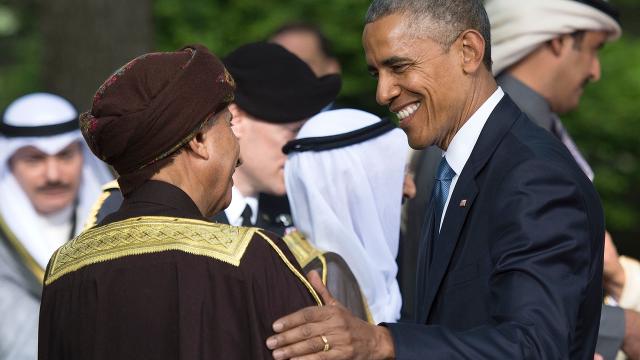The United States loves selling weapons to foreign governments. They really, really love it. Like, $55 billion in love.
President Obama hosts the Gulf Cooperation Council-US summit on 14 May 2015 at Camp David with leaders from Saudi Arabia, Kuwait, Bahrain, Qatar, the United Arab Emirates and Oman (Photo by Kevin Dietsch – Pool/Getty Images)
A new US government report based on unclassified data has helped elaborate on that love. The report, produced by the Congressional Research Service, explains that America is by far the largest arms dealer in the world. The United States sold roughly $US40 billion ($55 billion) worth of weapons in 2015, representing roughly half of all military weapons sold around the world. The second closest competitor was France, which sold a measly $US15 billion ($20.8 billion).
Qatar was the single largest purchaser of weapons in the developing world, allocating $US17.5 billion ($24.3 billion) for weapons. Egypt came in second, spending $US11.9 billion ($16.5), with Saudi Arabia in third, forking over $US8.6 billion ($11.9 billion) on conventional weapons.
The types of conventional weapons counted in the report are everything from tanks and supersonic aircraft to submarines and missiles. The list below breaks down the top 10 weapons suppliers in the world and how much they raked in during 2015.
Arms transfer agreements with the world in 2015
- United States: $US40.1 billion ($55.7 billion)
- France: $US15.3 billion ($21.2 billion)
- Russia: $US11.1 billion ($15.4 billion)
- China: $US6 billion ($8.3 billion)
- Sweden: $US1.5 billion ($2 billion)
- Italy: $US1 billion ($1.3 billion)
- Germany: $US900 million ($1.2 billion)
- Turkey: $US800 million ($1.1 billion)
- UK: $US700 million ($973 million)
- Israel: $US700 million ($973 million)
The global weapons trade was actually down in 2015 compared with 2014, leading to some interesting observations on the part of the authors of the report. Some weapons suppliers have been struggling to get developing countries with weak economies to spend, so weapons manufacturers in the United States have been offering things like flexible financing options — not unlike a used car salesperson or a subprime mortgage lender.
“To overcome the key obstacle of limited defence budgets in several developing nations, arms suppliers have increasingly utilised flexible financing options, and guarantees of counter-trade, co-production, licensed production, and co-assembly elements in their contracts to secure new orders,” the report said.
The report also notes that richer countries in the Persian Gulf and India have been able to demand better terms and more advanced weapons technologies on account of the relatively shrinking market for weapons in developing nations.
“The more affluent developing nations have been leveraging their attractiveness as clients by demanding greater cost offsets in their arms contracts, as well as transfer of more advanced technology and provisions for domestic production options,” the report explains.
And it wouldn’t be a report on US military interests without mention of Iran. Specifically, the report notes that sales to Saudi Arabia and the United Arab Emirates were robust — two countries which are “both pivotal partners in the U.S. effort to contain Iran”.
Donald Trump often held up a sign during the US presidential campaign purporting to show how much money the Clinton Foundation was raking in as a quid pro quo for arms sales to various countries. But if you take even a second to think about the amount of money that changes hands in these deals, it’s hard to believe that donations to the Clinton Foundation were even a drop in the bucket.
With or without the Clintons, the United States simply loves selling weapons. $US40 billion ($55 billion) worth every year, in fact. And it’s unlikely that this will change with the incoming administration. Unless President Trump decides that America’s economy can take a $US40 billion ($55 billion) per year hit.
